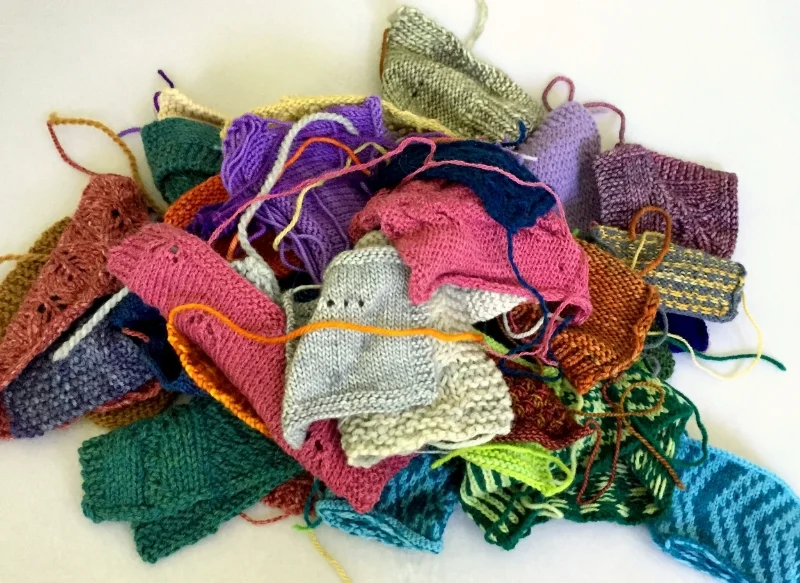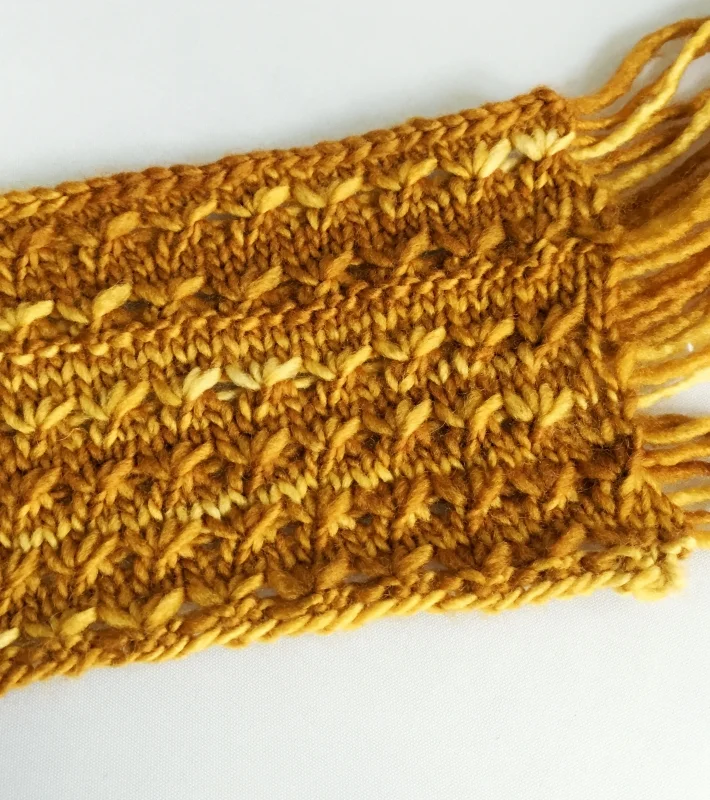Swatching and Gauge, Part III: Swatches that Lie and What to Do About Them
Now that we've talked about why you need to swatch and how to swatch correctly, let's address a controversial topic. One of the biggest arguments I've heard against swatching is that SWATCHES LIE! You go to all that effort to knit a swatch, you get gauge, you knit your sweater/socks/octopus warmer and IT DOESN'T FIT! Your gauge must have been off and now you've invested hours in a project that's useless.
This is EXTREMELY frustrating. And sometimes the problem IS the swatch--that is, you did everything right, but once worked into a sweater/sock/octopus warmer, the yarn didn't behave the same way it did in the swatch, so the information you got from your swatch didn't translate to your finished object. This is the most difficult problem to overcome, but one that is relatively rare. We'll talk about ways to avoid this situation a little later in the post.
More often, however, the problem is not the swatch itself but the way it was knit or handled after knitting that led to a discrepancy between swatch gauge and project gauge. This problem is easier to fix, so we'll start here!
Review: Swatching Essentials
First, a quick review of the secrets to swatching success I shared in the last post. The most common reasons a swatch "lies" are:
It's not large enough.
You counted the number of stitches in 1" rather than in 4".
The swatch is flat and the project is knit in the round.
The swatch wasn't washed and blocked the way the final garment was.
The swatch was stretched or otherwise manipulated to get gauge, but the final garment was not.
Those are the basics. Now let's look at a few more possibilities.
Troubleshooting: Why Gauge Changes
Using needles made of a different material. Even if the size is the same, your gauge is likely to be different depending on the material the needle is made of--wood, metal, carbon fiber, acrylic or anything else. It's important to swatch with the exact needles you'll use for your project.
Not checking gauge for different stitch patterns. If the designer didn't specify a gauge for stitch patterns used in the design, this implies that incorporating those patterns will not change the gauge significantly. However, if gauge is provided, you'll also need to swatch and check gauge for those stitch patterns.
Not checking gauge when switching between knitting flat and knitting in the round. This is particularly a concern for seamless cardigan patterns where the body is knit flat but the sleeves are knit in the round. The designer may assume that any change in gauge between working flat and in-the-round is minor and will not significantly affect the finished measurement; you personally, however, may find a major difference in your gauge working in-the-round vs. flat, so it's important to double check.
Real life affecting your gauge. If you're going through a difficult or stressful situation, you may find it affects your gauge! If you're feeling tense, you may knit more tightly than usual; conversely if you're on vacation, you might loosen up a bit--literally. So don't knit your gauge swatch when you're under a lot of job-related stress and then knit your sweater while you're relaxing on the beach with a fruity tropical drink--or vice versa.
Returning to an old project. If you abandon your project for a significant period of time, it's a good idea to double check your gauge when you return to it. When I was a "young" knitter, I knit very tightly and almost always had to go up a needle size to get gauge--sometimes several sizes! Today, I generally get gauge with the needle size specified in the pattern. We evolve as knitters.
Why Swatches Lie and How to Keep Them Honest
Now, with the knowledge you need to knit the "perfect" gauge swatch, what can you do to ensure that your swatch doesn't lie to you?
First, choose the right material for your project. Different fibers and different kinds of wool behave differently , some of which isn't readily apparent in a swatch. Superwash wool, for example, tends to grow. Alpaca has very little elasticity. Cotton is of course well-known for shrinking when thrown in the dryer. (A good resource of information on different fibers is the Fleece and Fiber Sourcebook.) Not all materials are right for every project, so even if you get gauge with a small swatch of 100% alpaca, that doesn't mean it's the right choice for a seamless pullover. Arm yourself with knowledge!
Second, any time you plan to use a new yarn, spend some time researching it on Ravelry before you start knitting. Look at projects where people have used your yarn, as well comments on the specific page for the yarn--any complaints about the yarn growing, shrinking or otherwise misbehaving? Take note. You may learn that your yarn felts very easily, so you'll need to be extra gentle when washing to avoid shrinkage. Or perhaps X sock yarn grows quite a bit after washing, so with that in mind, you'll knit your socks a little smaller.
And while knowing your yarn may not tell you exactly how your finished object will behave, it does lead to the very important step three...
Keep checking gauge. This is actually a good idea regardless, but especially if you know you're working with a tricky yarn or fiber--check your gauge while you're knitting. Stop every few inches or after every section, lay your piece on a flat surface, measure it, and compare with your original gauge and/or the schematic. This isn't an exact science, since you won't have washed and blocked your WIP, but it can help you catch any significant gauge changes early, before you've knit an entire sweater or pair of socks.
And what if you've already knit a sweater that doesn't fit? Take a peek at Carol Feller's Craftsy class, Sweater Surgery, where she teaches you how to modify an already completed sweater, including lengthening the body and sleeves. You can even turn a too-tight pullover into a cardigan by steeking! All is not lost.
Help! I Can't Get Gauge
And finally, what to do when you've swatched on all reasonable needle sizes and still can't get gauge? Before you give up, try using a needles made of a different material. For example, if you're using nickel-plated, try bamboo. The difference might be enough that you'll get gauge with a needle size you've already tried.
Still no dice? If you're not willing to change yarn (which is honestly your best bet), you have two options.
Option 1: Math. This can be very involved solution that should not be taken lightly. There's quite a bit of math involved in sizing garments, especially sweaters (and God forbid you want something with set-in sleeves!). However, if you absolutely must knit your garment with THIS yarn, rewriting the pattern for your gauge will give you the best outcome. Basically you're going to recalculate all the stitch counts based on your gauge--fairly straightforward math for a hat, rather complicated for a sweater. The amount of yarn you need will also change. If you're ready to take the plunge, I suggest purchasing a good knitting or pattern design resource book or checking one out of the library to guide you through all the math. Try June Hemmons Hiatt's Principles of Knitting or Shirley Paden's Knitwear Design Workshop. You can also refer to Amy Herzog's brilliant Knit to Flatter class on Craftsy.
Option 2: Knit a different size at the wrong gauge. This is a very VERY imperfect solution. But if you can't stomach the math, your gauge difference is minor and the intervals between sizes are relatively small, it might work for you. Like I said, you're really better off picking a different yarn. But if you're stubborn (as I was when I knit my Wildflower Cardigan), read on. You'll still need to do a little math to check the numbers--don't just pick a bigger/smaller size and start knitting. Find the number of stitches at the bust for the sweater 1 size bigger or smaller than the size you actually want, and divide by your stitch gauge to find the size you'll get. For example, if the specified gauge for a sweater is 6 stitches per inch, the 36" bust will have 216 stitches; if your gauge is 6.5 sts per inch, following instructions for that 36" sweater would actually give you a sweater about 33.25" (216/6.5) around at the bust.
That's it! I hope you've enjoyed this series on swatching and gauge! Any suggestions for my next knitting education series?
If you enjoyed this post, you may also like . . .







